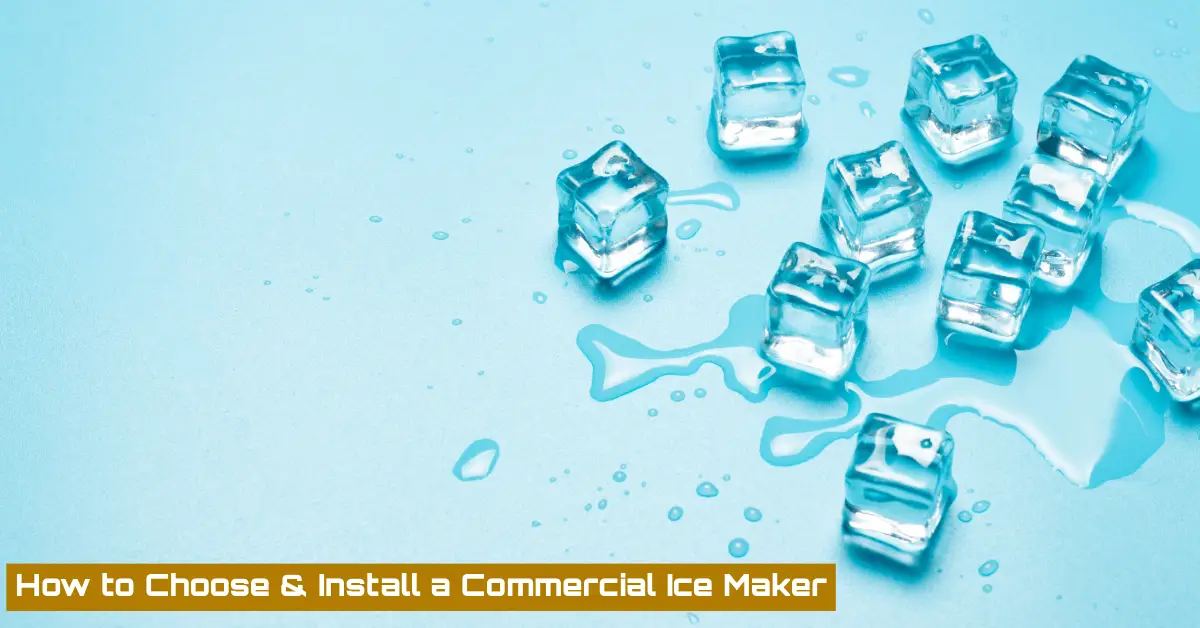
Commercial ice makers are indispensable appliances in the food and beverage industry, providing a steady supply of ice for drinks, food preservation, and more. Whether you run a bustling restaurant, a cozy café, or a high-traffic bar, understanding how these machines work, how to install and maintain them, and the best practices for ice production can significantly impact your business. Let’s dive into the intricate world of commercial ice makers and explore everything from installation to maintenance.
Contents
The Inner Workings of a Commercial Ice Maker
At its core, a commercial ice maker operates on a simple principle: freezing water to create ice. However, the process involves several key components and stages that ensure efficient and consistent ice production.
- Water Supply and Filtration: It all starts with water. The quality of water is crucial, as impurities can affect the clarity and taste of the ice. Most commercial ice makers are equipped with filters to remove these impurities, ensuring crystal-clear ice.
- Refrigeration System: The refrigeration system is the heart of the ice maker. It includes an evaporator plate that gets extremely cold, causing the water to freeze upon contact. As water flows over the plate, it begins to form ice.
- Harvesting Cycle: Once the ice reaches the desired thickness, the machine enters a harvest cycle. Here, the evaporator plate warms slightly, releasing the ice, which then falls into a storage bin. The type of ice produced—cubes, flakes, or nuggets—depends on the design of the machine.
- Storage and Dispensing: The ice is stored in an insulated bin, ready to be used. Some machines come with automatic dispensers, while others require manual scooping.
This process is automated, allowing for continuous production of ice as long as the machine is connected to a water source and has power.
Installation Tips for Commercial Ice Makers
Proper installation is key to the efficient operation and longevity of your commercial ice maker. Here’s a step-by-step guide to get your machine up and running:
- Selecting the Right Location: Choose a location that provides sufficient space for the machine, including ground clearance for air circulation. This helps prevent overheating and ensures the machine operates efficiently.
- Water Supply Connection: Attach the ice maker to a dedicated water line, preferably with a filtration system. This not only improves the quality of the ice but also protects the machine from scaling and mineral buildup.
- Drainage Setup: Most commercial ice makers require a floor sink or drain to manage wastewater. This step is crucial to prevent flooding and maintain hygiene standards.
- Electrical Requirements: Ensure that the power supply matches the ice maker’s specifications. It’s advisable to have a professional electrician handle the electrical connections, especially for larger units.
- Leveling the Machine: A perfectly level ice maker is essential for even ice production and to avoid water spillage. Use a level to check and adjust the machine as necessary.
- Initial Testing: Once installed, run the machine through a few cycles to ensure everything is functioning correctly. Check for any leaks or unusual noises.
Maintenance and Troubleshooting
Maintaining your commercial ice maker is crucial for consistent ice production and longevity. Here are some tips and common issues:
Resetting the Machine: If your ice maker isn’t working properly, a reset can sometimes resolve the issue. Typically, this involves turning off the machine, unplugging it, and waiting a few minutes before restarting. Always refer to your machine’s manual for specific instructions.
Addressing Cloudy Ice: Cloudy ice is usually a result of impurities in the water or air bubbles trapped during freezing. Using filtered water can help produce clearer ice. Regularly cleaning and descaling the machine also prevents mineral buildup, which can cloud the ice.
Unplugging and Winterizing: If you need to unplug your ice maker for an extended period, be sure to empty the ice bin and drain any water to prevent mold growth. In colder climates, winterizing the machine is crucial to prevent freezing and cracking of components. This involves draining all water from the system and disconnecting it from the water supply.
Choosing the Right Ice Maker and Water Type
Selecting the right commercial ice maker involves considering your specific needs, such as the type and volume of ice required. Here are some factors to consider:
Type of Ice: Different types of ice serve different purposes. For example, cube ice is ideal for beverages, while flake ice is often used in food displays. Nugget ice, also known as “chewable ice,” is popular in healthcare and fast-food settings.
Production Capacity: Match the machine’s capacity with your business needs. Overestimating can lead to wasted energy and space, while underestimating can leave you short on ice during peak times.
Energy Efficiency: Look for machines with Energy Star ratings or other certifications indicating efficient energy use. This not only reduces operating costs but also minimizes environmental impact.
Water Quality: The quality of water used is vital for the quality of the ice. Many businesses use reverse osmosis (RO) systems to filter the water before it reaches the ice maker. This ensures the ice is free of impurities and has a better taste and appearance.
When to Replace Your Ice Maker
If your ice maker is several decades old, it might be time to consider an upgrade. Modern machines are more energy-efficient, produce better quality ice, and offer advanced features like self-cleaning functions. If your machine frequently breaks down, produces less ice, or the ice quality has declined, these are strong indicators that a replacement is needed.
Conclusion
Commercial ice makers are essential for any business that serves cold beverages or requires ice for food preservation. From understanding how these machines work to installing, maintaining, and even troubleshooting them, being informed can help you make the best decisions for your business. Whether you’re looking to install a new unit or maintain an existing one, a little knowledge goes a long way in ensuring smooth, uninterrupted ice production. So, the next time you enjoy a perfectly chilled drink or a creamy soft serve, you’ll know the intricate process behind these everyday delights!








